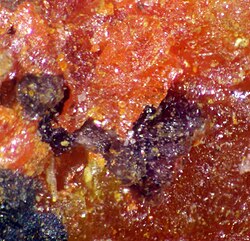Top Qs
Timeline
Chat
Perspective
Christite
Mineral From Wikipedia, the free encyclopedia
Remove ads
Christite is a mineral with the chemical formula TlHgAsS3. It is named after Dr. Charles L. Christ, a member of the U.S. Geological Survey. It usually comes in a crimson red or bright orange color. It has a density of 6.2 and has a rating between 1 and 2 on Mohs Hardness Scale. Christite has an adamantine luster and leaves behind an orange streak.[3] Its crystal system is monoclinic with possible crystal classes of twofold symmetry, mirror plane symmetry, and twofold with a mirror plane. This means it can have radial symmetry, mirror plane symmetry, or mirror plane symmetry perpendicular to the two-fold axis.[5] It is an anisotropic mineral, which means that it exhibits different properties when measured in different directions. In plane polarized light, its color is golden yellow. It is birefringent, which means that it has two distinct indices of refraction. This can be seen when one looks through the microscope with both polars crossed and sees the mineral change colors when it is rotated.
Remove ads
Occurrence
Christite occurs with baryte in hydrothermal veins in dolomite at the Carlin mine in Nevada and in pods within a mercury deposit, the Lanmuchang deposit, China.[4] It occurs associate with realgar, orpiment, lorandite, baryte and getchellite at the Carlin mine and with lorandite, baryte, pyrite and marcasite in the Lanmuchang.[4]
References
Wikiwand - on
Seamless Wikipedia browsing. On steroids.
Remove ads

